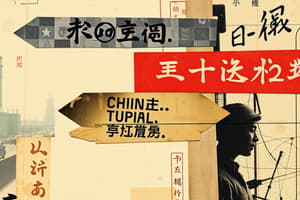Podcast
Questions and Answers
What is the primary role of the Yueqin in local operas?
What is the primary role of the Yueqin in local operas?
The Yueqin is used to accompany local operas.
How does the Erhu differ in use compared to other instruments?
How does the Erhu differ in use compared to other instruments?
The Erhu is versatile and can be used as a solo instrument, in solo ensembles, or with large orchestras.
What is the unique characteristic of the Dizi that affects its sound?
What is the unique characteristic of the Dizi that affects its sound?
The Dizi has a membrane over an extra hole, creating a unique rattling sound.
Describe the structure and function of the Sheng.
Describe the structure and function of the Sheng.
What types of sounds can the Yunluo produce based on gong thickness?
What types of sounds can the Yunluo produce based on gong thickness?
Flashcards are hidden until you start studying
Study Notes
Yueqin
- A moon-shaped lute with a shorter neck and 4 strings
- Played with a spectrum (plectrum)
- Used for accompanying local operas
PipA
- 4-stringed lute with 30 frets
- Pear-shaped body
- Extremely wide dynamic range and remarkable expressive power
Erhu
- 2-stringed fiddle
- One of the most popular Chinese instruments
- Used as a solo instrument, in solo ensembles, and in large orchestras
- Played by various ethnic groups
Yunluo
- A set of 10 small, tuned gongs mounted in a wooden frame
- Gongs have equal diameter but vary in thickness
- Thicker gongs produce higher pitches
Sheng
- Known as the Chinese mouth organ
- A set of panpipes made of bamboo
- Has 12 to 36 pipes of varying lengths
- Each pipe has a brass reed at the bottom and a note sounds when the player blocks a hole on the pipe
Dizi
- Traditional Chinese flute
- Has a membrane over an extra hole, creating a unique rattling sound
- Played by blowing across the mouthpiece and using 6 finger holes
Zheng
- Ancient Chinese instrument with an arched surface
- Elongated trapezoid shape
- 13-21 strings, each stretched over individual bridges
- Covers a range of 2-4 octaves
Pengling
- 2 small, high-tin bronze bells without internal clappers
- Shaped like hemispheres or bottomless gourds
- Produces a delicate, clear, melodious tone
- Rhythmic instrument used in ensembles or theater
- Often used to create an effect of peaceful dreams
Studying That Suits You
Use AI to generate personalized quizzes and flashcards to suit your learning preferences.




